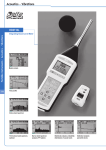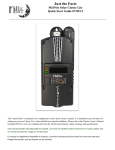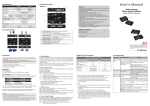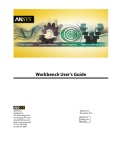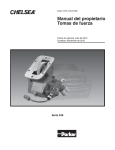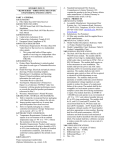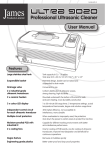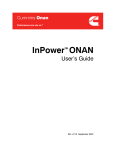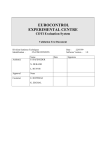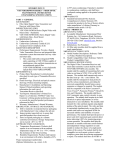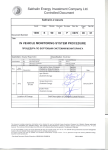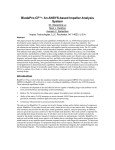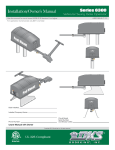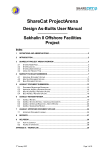Download to user manual.
Transcript
8 Reference: Ford SEIC Bulletins: 2011 Gas 2011 Diesel 2008 - 2010 InPO WER the systems people Q-173-R2 Q180-A Q-172 OWNERS MANUAL Model ETM51 Electronic Throttle Module 2005+ Ford Gas & Diesel Engines A. Introduction Relay circuit for fully automatic reset for 2011 and later F-Series Gas Engines On/Off Fused +12 Volts 30 85 87 86 To Ford SEIC wires: PTO RS2 (PTO_ENGAGE) (Blu/Orange) (Some early 2011 builds used Blue/Gray) View looking into OBD-II connector located on lower dash on drivers side. Shield CANH (Yellow) PTO_RELAY (Blue/White) 1 2 3 4 5 6 7 8 9 10 11 12 13 14 15 16 PTO RPM (Green) CANL (Green) B. Operation PTO RS1 (PTO MODE)(YellowGreen) Green (Pin 14) RPM3 RPM2 RPM1 PTO +12V RPM REF Ground GND InPower ETM51 RPM1 Shield (Pin 5) Yellow (Pin 6) CANL CANH VRPM RPM1 RPM2 RPM3 VRPM APDL BUS GEAR PK BRK SR BRK VSPD RPM2 RPM3 Green The InPower Model ETM51 electronic throttle module is designed for installation in 2005+ Ford trucks and vans that are equipped with the Ford Stationary Elevated Idle Control (SEIC) and have one the following engines: 6.4 Liter Power Stroke Diesel 6.8 Liter Triton Gas 6.0 Liter Power Stroke Diesel 5.4 Liter Triton Gas 6.7 Liter Power Stroke Diesel 6.2 Liter Triton Gas Four modes of fast idle control are provided, including three fast idle preset speeds (user adjustable), and a variable speed input (remote variable resistor). The ETM51 electronic throttle installation requires customer supplied control wiring to select the required mode of operation and to connect to the Ford SEIC (Stationary Elevated Idle Control) wiring (Ford provides blunt-cut wires). This wiring connects to the ETM51 module via 0.25 inch Faston (blade) terminals. The ETM51 system is supplied with a three-foot shielded data cable. This cable contains a 16-pin connector at one end and two 0.25 inch Faston terminals at the other end. The Faston terminals will connect at the ETM51 module and the 16-pin connector plug will attach to the vehicle’s OBDII (On Board Diagnostic) data link connector (DLC). The DLC is usually located at the lower part of the dash on the driver’s side. Yellow When the vehicle is parked and Chassis Ready Conditions are satisfied the engine speed may be controlled by one of the four available modes (three preset speeds or the variable rpm). The preset speed may be adjusted by three calibration potentiometers on the top of the ETM51 module. Chassis Ready Conditions are: 1. Parking brake is set 2. Gear shift in “Park” (automatic transmission only) 3. Foot is off service brake 4. Foot is off the accelerator pedal 5. Vehicle is stationary (no speed) 6. Engine is started and idling below 900 rpm 7. Coolant temperature >140° F (Gas), 120° F (Diesel) 8. Transmission temperature 20° F to 240° F RPM 1 Fused +12 Volts Owners Manual InPOWER LLC 3555 Africa Road Galena, Ohio 43021 U.S.A (740)548-0965 www.InPowerDirect.com Model ETM51 Electronic Throttle Document: OM-54 Version H Date: January 24, 2012 © Copyright 2012 InPower LLC Important Notes: 1. Do not connect any other 12 volt source to the ETM51’s PTO terminal! 2. If the engine is in the fast idle mode and one of the Chassis Ready Conditions inputs changes state, the engine will return to normal (low) idle speed. If the input then returns to satisfy the Chassis Ready Conditions while the fast idle mode is still selected, the diesel engine will automatically return to fast idle after about three seconds. However, the gas engines and the 2011 and later diesel engine will not automatically return to the fast idle speed. To reset the Ford SEIC so that it will return to the fast idle, you must turn off the Fast Idle On/Off switch, then turn it back on. With the ETM51 Rev. H and later software the reset can be accomplished automatically on gas engine systems with the addition of a relay circuit (see page 8). ETM51 OM-54H 2 7 Modes Of Operation: 1. Three Preset RPM High Idle Modes: Function: Increase idle to a preset rpm value Terminals: RPM1, RPM2, RPM3 Activation: Apply +12 V to terminal Range of Calibration: 900 to 2250 rpm (gas engines) 1200 to 2300 rpm (2005 - 2010 diesel engine) 900 to 3000 rpm (2011 and later diesel engine) Enable: Disengage: RPM Range: PTO GEAR On Solid GEAR Flashing PK BRK PK BRK SR BRK SR BRK VSPEED VSPEED On Solid Flashing On Solid Flashing On Solid Flashing Indication Module ON and functioning Module ON, but a problem with CAN bus communications Transmission in PARK position or Clutch Pedal released Transmission not in PARK position or Clutch Pedal activated Park Brake set Park Brake not set Service Brake at rest (not activated) Service Brake activated Vehicle stationary Vehicle moving ETM51 OM-54H Ground GND InPower ETM51 REF RPM1 CANL CANH Shield CANH (Yellow) RPM2 RPM3 Yellow Green VRPM 1 2 3 4 5 6 7 8 9 10 11 12 13 14 15 16 CANL (Green) View looking into OBD-II connector located on lower dash on drivers side. Customer To Supply Fast Idle RPM 1 On RPM 2 * Off RPM 3 * Status Indicators A 10 segment LED provides status and problem detection information. Refer to the following table for coding of these functions. Status On Solid Flashing Shield (Pin 5) Yellow (Pin 6) +12V RPM Highest - Will override RPM2, RPM3, VRPM Second - Will override RPM3, VRPM Third - Will override VRPM Lowest - Will only activate when other modes are off LED BUSS BUSS Green (Pin 14) RPM3 RPM2 RPM1 3. Mode Priorities: A mode priority selection scheme is provided that will eliminate conflicts if more than one mode is selected at a time. In the case of one or more modes being selected, the following priorities will be established: RPM1 RPM2 RPM3 Variable RPM WARNING! Do not connect any 12 volt source to the PTO terminal wiring. Three potentiometers accessible from the top of the module Varies rpm as a function of voltage on VRPM input terminal VRPM 10K Ohm potentiometer between the VRPM terminal and ground Turn potentiometer down to zero resistance, then slowly increase until desired rpm is reached Turn potentiometer down to zero and rpm will drop to standard idle speed 900 to 2250 rpm (gas engines) 1200 to 2300 rpm (2005 - 2010 diesel engine) 900 to 3000 rpm (2011and later diesel engine) OBD-II Diagnostic Connector Ford SEIC Blunt-Cut Wires (See table for wire colors) RPM1 RPM2 RPM3 VRPM APDL Terminal: Adjustment: X X X Ford Chassis VSPD 2. Variable RPM Mode: Function: PTO PTO RPM PTO VREF BUS GEAR PK BRK SR BRK Type of Adjustment: DIESEL ENGINE CHASSIS WIRING DIAGRAM Fuse +12 V Ignition (This supply must be from a circuit with no other loads such as relays that might generate electrical noise) RPM Control * 10,000 Ohm 10-Turn Chassis Ground (Battery Neg.) * Optional FORD SEIC WIRE COLOR CHART F-Series Diesel Function PTO 2005 - 2007 6.0 L Orange 2008 - 2010 6.4 L 2011 and later 6.7 L E-Series Diesel 2005 - 2008 6.0 L 2009 6.0 L Yellow/Green Yellow/Green Purple/Lt. Blue Yellow/Green PTO RPM Orange/Yellow Green Green Orange/Yellow Green PTO VREF Orange/Red White/Brown White/Brown Orange/Red White/Brown ETM51 OM-54H 6 3 GAS ENGINE CHASSIS WIRING DIAGRAM PTO ENGAGE PTO RPM PTO MODE X X X Status Indicators (Continued) FORD CHASSIS OBD-II Diagnostic Connector Ford SEIC Blunt-Cut Wires (See table for wire colors) WARNING! Do not connect any 12 volt source to the PTO terminal wiring. Green (Pin 14) RPM3 RPM2 RPM1 PTO +12V RPM REF Shield (Pin 5) Yellow (Pin 6) Ground GND InPower ETM51 RPM1 CANH RPM1 RPM2 RPM3 VRPM APDL BUS GEAR PK BRK SR BRK VSPD Yellow Green VRPM Shield CANH (Yellow) 1 2 3 4 5 6 7 8 9 10 11 12 13 14 15 16 CANL (Green) View looking into OBD-II connector located on lower dash on drivers side. Customer To Supply Fast Idle RPM 1 * On * RPM 2 * RPM 3 * RPM Control Off Fuse 10,000 Ohm 10-Turn Chassis Ground (Battery Neg.) Optional NOTES: 1. Engine must be running and all Chassis Ready Conditions must be correct before closing this switch! (Gas engines only.) 2. Refer to relay diagram on page 8 for automatic reset circuit for F-Series gas engines. +12 V Ignition (This supply must be from a circuit with no other loads such as relays that might generate electrical noise.) FORD SEIC WIRE COLOR CHART E-Series Gas F-Series Gas Function PTO MODE PTO RPM 2005 - 2007 5.4 L & 6.8 L Orange Orange/Yellow PTO ENGAGE Orange/White On Solid Flashing RPM2 RPM2 On Solid Flashing RPM3 RPM3 On Solid Flashing VRPM Off VRPM On Solid VRPM Flashing APDL APDL On Solid Flashing CANL RPM2 RPM3 RPM1 RPM1 2008-2010 5.4 L & 6.8L 2011 and later 6.2 L & 6.8 L 2005 - 2008 5.4 L & 6.8L 2009 - 2012 5.4 L & 6.8 L Yellow/Green Yellow/Green Orange Yellow/Green Green Green Orange/Yellow Green Blue/Green Blue/Orange* Orange/White Blue/Green RPM1 mode selected, engine at fast idle RPM1 mode selected, engine not at fast idle (PCM not responding*) RPM2 mode selected, engine at fast idle RPM2 mode selected, engine not at fast idle (PCM not responding*) RPM3 mode selected, engine at fast idle RPM3 mode selected, engine not at fast idle (PCM not responding*) VRPM terminal at zero resistance value (engine at idle) or open circuit VRPM terminal increases above threshold level and engine speed increases accordingly. VRPM terminal increases above threshold level but engine does not respond with elevated speed. Accelerator pedal at rest position Accelerator pedal actuated (not at rest position) * The Ford powertrain control module (PCM) is not responding to the fast idle speed request. This could be caused by a chassis ready conditions issue or some other PCM system problem. This could also be caused by the failure to power the ETM51’s +12 volt input until after the engine is started and engine temperature is over 140° F. See note on page 6. C. Installation 1. Getting Started The recommended location for the ETM51 system is under the dash due to the proximity of the wiring connections and cable length. The unit should not be located in the engine compartment, or any location that is not protected. You will need a crimping tool for the 0.25 inch Faston (blade) terminals, and a wire stripping tool. Be sure to follow the crimping tool instructions for the proper wire size and terminals. Do not lengthen the DLC Cable. Disconnect the battery before making any electrical connections. 2. Mount the ETM51Module Mount the ETM51 module under the dash on a flat surface using the two mounting holes. Ensure that you have sufficient distance to install the 36 inch long DLC cable. 3. Install the DLC Cable Connect the two Faston terminals on the DLC cable to the ETM51 module terminals (Yellow wire to CANH terminal and Green wire to CANL terminal). Route the cable to the OBDII Data Link Connector and plug it in. The OBDII connector is usually located on the lower part of the dash on the driver’s side. Using a cable tie, secure the plug to the OBDII connector so that it will not vibrate out. We recommend that you route the DLC cable back across the bottom of the plug/connector, and loop the cable tie around the plug, socket and cable, thereby keeping the cable out of the way. Also ensure that the entire cable is routed and secured to keep it out of the way. * Some early chassis builds had a Blue/Gray wire. ETM51 OM-54H ETM51 OM-54H 4 5 C. Installation (Cont’d): E. Specifications 4. Wire the Mode Selection and SEIC Controls This section describes the wiring necessary to connect the ETM51 electronic throttle to the Ford SEIC blunt-cut wires and to the Mode Selection controls (“Customer to Supply”). As the wiring is different for gas and diesel engine applications, refer the appropriate wiring diagrams on page 6 and 7. You will also need to obtain a good quality chassis ground (battery negative) and a +12 volt supply that is fed from the Ignition Switch. Note that on gas engine installations, Ford requires this +12 volt supply to be “clean.” That is, it should not have any other loads such as relays on the same circuit that could generate electrical noise. 8 to 16 volts 30 mA 0.17 lbs Faston 0.25 inch terminals Cyolac thermoplastic (UL 94VO) Epoxy potting compound, resistant to most fuels, oils, acids, and cleaning agents. 4.00 3.50 PTO RPM REF RPM1 RPM2 RPM3 RPM1 RPM2 RPM3 VRPM APDL GND +12V CANL Preset speed calibration potentiometers (3 places) RPM3 RPM2 RPM1 BUS GEAR PK BRK SR BRK VSPD CANH Note on Variable RPM Control - If you are using the Variable RPM mode you will need to supply a 10,000 ohm variable resistor (potentiometer) between the VRPM terminal on the ETM module and ground. We recommend a ten-turn potentiometer such as is available from Williams Controls (www.wmco.com), or Digikey (www.digikey.com). Mechanical Weight: Connections: Case Material: Encapsulation Material: VRPM 4A. Idle Speed Mode Controls First, determine the combination of fast idle speed modes that you will need (variable rpm control and/or up to three fixed preset speeds). You will need a 10,000 Ohm potentiometer for the variable rpm control, and a switch (or relay contact) for the fixed speed presets (RPM1, RPM2 & RPM3). You will also need a Fast Idle On/Off switch. Wire these devices as shown in the Wiring Diagram - Gas Engines (Page 6) and Wiring Diagram - Diesel Engines (Page 7). You will need to obtain a good quality chassis ground (battery negative) and a +12 volt fused supply fed from the Ignition Switch. Refer to the Ford Body Builders Layout Book for location of these circuits. Electrical Input Voltage (+12V Terminal): Input Current (+12V Terminal): 0.1875 2.05 1.025 0.25 Inch Faston Terminals 0.50 4B. Ford SEIC Wiring Install wires between the ETM51 module and the Ford SEIC as shown in the wiring diagrams on page 5 and 6. The Ford SEIC wires are blunt-cut, color coded wires located above the parking brake pedal on the F-Series trucks. On E-Series vans they are located in the engine compartment on the top, driver’s side of the firewall. Refer to Ford SEIC documentation for more details. Note that the wiring is different for the gas and diesel engines. Also, the gas engine application requires a “clean” +12 volt power source. This must be a +12 volt circuit switched by the ignition switch that is isolated from other circuits. That is, no other loads such as relays can be on the same circuit. WARNING! Do not connect any 12 volt source to the ETM51’s PTO terminal wiring. D. Setup and Calibration The only calibration required is to select each of the three preset rpm modes (RPM1, RPM2 & RPM3) and adjust the three respective calibration potentiometers on the top of the ETM51 module to the desired speed (900 through 2,250 rpm on gas engines, 1200 to 2300 rpm on the 2005 - 2010 diesel engine and 900 to 3000 on the 2011 and later diesel engine). Adjustments can be made with a 1/16” (1.6 mm) or smaller screw driver. Each potentiometer is a ten turn device, with an increase or decrease of about 300 rpms per complete turn. ETM51 OM-54H All dimensions in inches. Not to scale. F. Customer Support Technical Support For product support, contact InPower at 740-548-0965 or 866-548-0965. Product bulletins and owner’s manuals are available on our web site: www.InPowerDirect.com. Warranty InPOWER LLC warrants its products to be free from defects in material and workmanship under normal use, care and maintenance for a period of two (2) years from the date of shipment. Please see www.inpowerdirect.com/warranty.htm for specifics or call 866-548-0965 for a copy of our warranty policy. Customer Evaluation InPower wants to ensure total customer satisfaction. Please download a product evaluation form at www.InPowerDirect.com/Customer_evaluation.htm or call us toll free at 866-548-0965 to be sent a form by mail. ETM51 OM-54H




